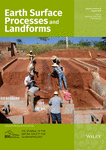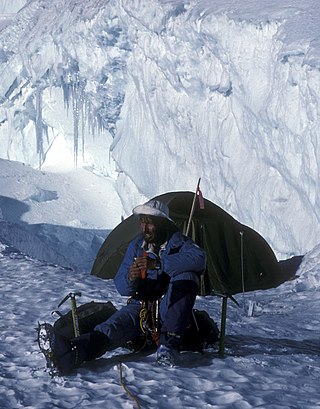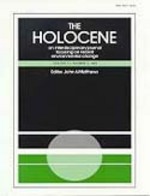The Holocene is the current geological epoch. It began approximately 11,700 years before 2000 CE. It follows the Last Glacial Period, which concluded with the Holocene glacial retreat. The Holocene and the preceding Pleistocene together form the Quaternary period. The Holocene has been identified with the current warm period, known as MIS 1. It is considered by some to be an interglacial period within the Pleistocene Epoch, called the Flandrian interglacial.
The Younger Dryas, which occurred circa 12,900 to 11,700 years BP, was a return to glacial conditions which temporarily reversed the gradual climatic warming after the Last Glacial Maximum (LGM), which lasted from circa 27,000 to 20,000 years BP. The Younger Dryas was the last stage of the Pleistocene epoch that spanned from 2,580,000 to 11,700 years BP and it preceded the current, warmer Holocene epoch. The Younger Dryas was the most severe and longest lasting of several interruptions to the warming of the Earth's climate, and it was preceded by the Late Glacial Interstadial, an interval of relative warmth that lasted from 14,670 to 12,900 BP.

Loess is a clastic, predominantly silt-sized sediment that is formed by the accumulation of wind-blown dust. Ten percent of Earth's land area is covered by loess or similar deposits.

The Last Glacial Period (LGP), also known colloquially as the last ice age or simply ice age, occurred from the end of the Eemian to the end of the Younger Dryas, encompassing the period c. 115,000 – c. 11,700 years ago. The LGP is part of a larger sequence of glacial and interglacial periods known as the Quaternary glaciation which started around 2,588,000 years ago and is ongoing. The definition of the Quaternary as beginning 2.58 million years ago (Mya) is based on the formation of the Arctic ice cap. The Antarctic ice sheet began to form earlier, at about 34 Mya, in the mid-Cenozoic. The term Late Cenozoic Ice Age is used to include this early phase. The previous ice age, the Saale glaciation, which ended about 128,000 years ago, was more severe than the Last Glacial Period in some areas such as Britain, but less severe in others.
Before Present (BP) years, also known as "time before present" or "years before present (YBP)", is a time scale used mainly in archaeology, geology and other scientific disciplines to specify when events occurred relative to the origin of practical radiocarbon dating in the 1950s. Because the "present" time changes, standard practice is to use 1 January 1950 as the commencement date (epoch) of the age scale. The abbreviation "BP" has been interpreted retrospectively as "Before Physics", which refers to the time before nuclear weapons testing artificially altered the proportion of the carbon isotopes in the atmosphere, which scientists must now account for.

There have been five or six major ice ages in the history of Earth over the past 3 billion years. The Late Cenozoic Ice Age began 34 million years ago, its latest phase being the Quaternary glaciation, in progress since 2.58 million years ago.
The impact factor (IF) or journal impact factor (JIF) of an academic journal is a scientometric index calculated by Clarivate that reflects the yearly mean number of citations of articles published in the last two years in a given journal, as indexed by Clarivate's Web of Science.

The Anglian Stage is the name used in the British Isles for a middle Pleistocene glaciation. It precedes the Hoxnian Stage and follows the Cromerian Stage in the British Isles. The Anglian Stage is correlated to Marine Isotope Stage 12, which started about 478,000 years ago and ended about 424,000 years ago.
Law & Society Review is a peer-reviewed academic journal in the field of law and society, which is part of the larger field known as the sociology of law. It was established by the Law and Society Association in 1966 and is published by Wiley-Blackwell. It has four issues per volume per year.
The Journal of Quaternary Science is a peer-reviewed academic journal published on behalf of the Quaternary Research Association. It covers research on any aspect of quaternary science. The journal publishes predominantly research articles with two thematic issues published annually, although discussions and letters are occasionally published along with invited reviews. According to the Journal Citation Reports, the journal has a 2012 impact factor of 2.939.
Quaternary science is the study which represents the systematic study of the Quaternary Period commonly known as the ice age. The Quaternary Period is a time period that started around 2.58 million years ago and continues today. This period is divided into two epochs – the Pleistocene Epoch and the Holocene Epoch. The aim of Quaternary science is to understand everything that happened during the Pleistocene Epoch and the Holocene Epoch to be able to acquire fundamental knowledge about Earth's environment, ecosystem, climate changes, etc. Quaternary science was first studied during the nineteenth century by Georges Cuvier, a French scientist. Most Quaternary scientists have studied the history of the Quaternary to predict future changes in climate.

Earth Surface Processes and Landforms is a peer-reviewed scientific journal published by John Wiley & Sons on behalf of the British Society for Geomorphology. It covers geomorphology and more in general all aspects of Earth sciences dealing with the Earth surface. The journal was established in 1976 as Earth Surface Processes, obtaining its current name in 1981. The journal primarily publishes original research papers. It also publishes Earth Surface Exchanges which include commentaries on issues of particular geomorphological interest, discussions of published papers, shorter journal articles suitable for rapid publication, and commissioned reviews on key aspects of geomorphological science. Foci include the physical geography of rivers, valleys, glaciers, mountains, hills, slopes, coasts, deserts, and estuary environments, along with research into Holocene, Pleistocene, or Quaternary science. The editor-in-chief is Stuart Lane.

Boreas is a peer-reviewed academic journal that has been published on behalf of the Collegium Boreas since 1972. The journal covers all branches of quaternary research, including biological and non-biological aspects of the quaternary environment in both glaciated and non-glaciated areas. Formerly published by Taylor & Francis, Boreas has been published by Wiley-Blackwell since 1998. According to the Journal Citation Reports, the journal has a 2012 impact factor of 2.457.

Matthias Kuhle was a German geographer and professor at the University of Göttingen. He edited the book series Geography International published by Shaker Verlag.
Island Arc is a peer-reviewed quarterly scientific journal that was established in 1992, covering "Earth Sciences of Convergent Plate Margins and Related Topics". It is published by Wiley-Blackwell on behalf of the Geological Society of Japan, in association with the Japan Association for Quaternary Research, Japan Association of Mineralogical Sciences, Palaeontological Society of Japan and the Society of Resource Geology.
American Museum Novitates is a peer-reviewed academic journal published by the American Museum of Natural History. It was established in 1921. According to the Journal Citation Reports, the journal has a 2013 impact factor of 1.636.
Quaternary International is a peer-reviewed scientific journal on quaternary science published by Elsevier on behalf of the International Union for Quaternary Research. The journal was established in 1989 and covers full spectrum of the physical and natural sciences that are commonly employed in solving problems related to the quaternary period. The editor-in-chief is Min-Te Chen.

The Holocene is a peer-reviewed scientific journal that covers research in the field of environmental studies, in particular environmental change over the last c. 11,500 years, particularly the interface between the long Quaternary record and the natural and human-induced environmental processes operating at the Earth's surface today. It is published eight times a year by SAGE Publications. The editor-in-chief is John A. Matthews.
Research in Autism Spectrum Disorders is a peer-reviewed medical journal published by Elsevier. It covers applied topics pertaining to autism spectrum disorders. The founding editor-in-chief was Johnny Matson, who was succeeded by Sebastian Gaigg in 2015. The journal is abstracted and indexed in the Social Sciences Citation Index and Current Contents/Social & Behavioral Sciences. According to the Journal Citation Reports, the journal has a 2012 impact factor of 2.907.
Permafrost and Periglacial Processes is a quarterly peer-reviewed scientific journal covering research on permafrost and periglacial geomorphology. It covers the subject from various points of views including engineering, hydrology, process geomorphology, and quaternary geology. It is the official journal of the International Permafrost Association and is published by John Wiley & Sons. The editor-in-chief is Mauro Guglielmin. According to the Journal Citation Reports, the journal has a 2020 impact factor of 4.368.







